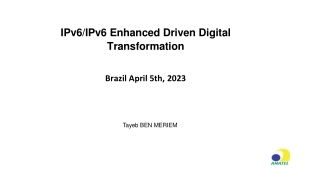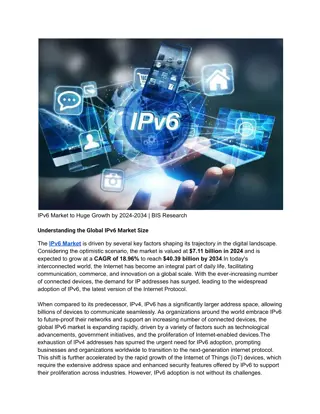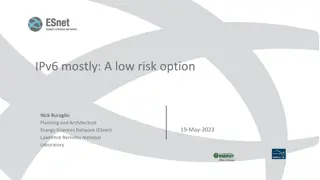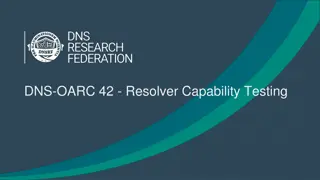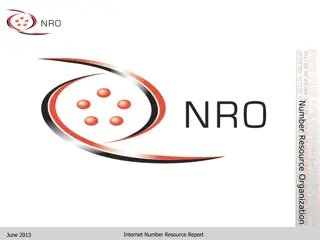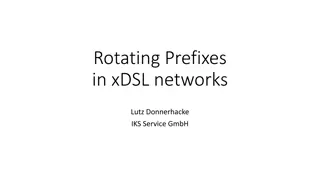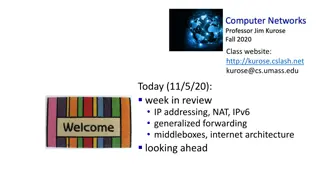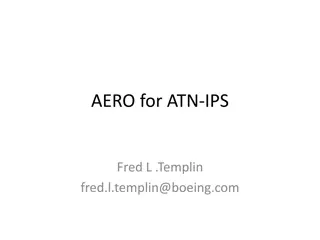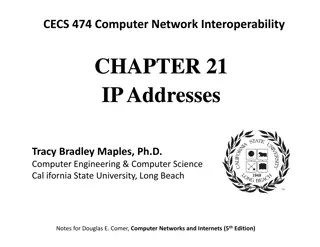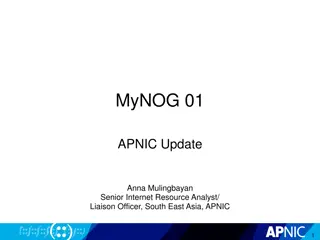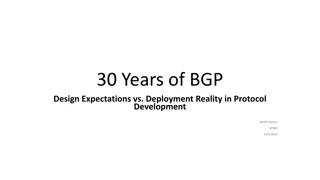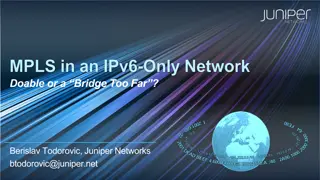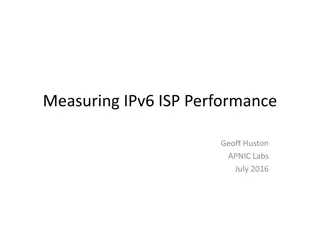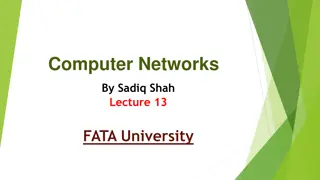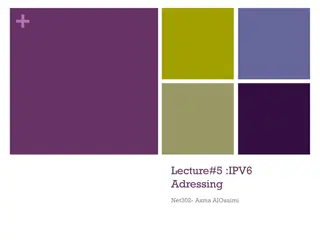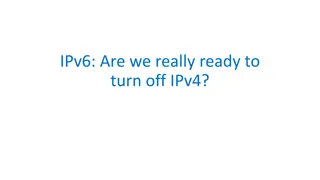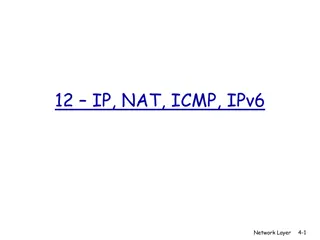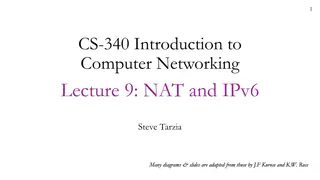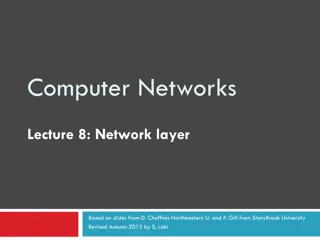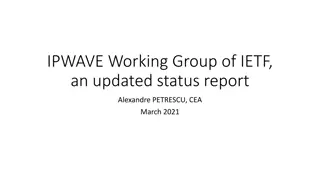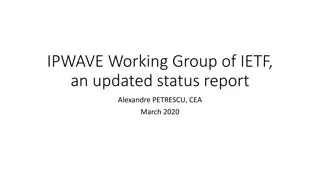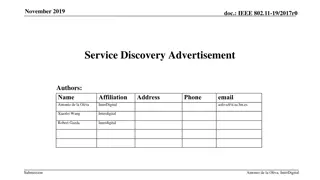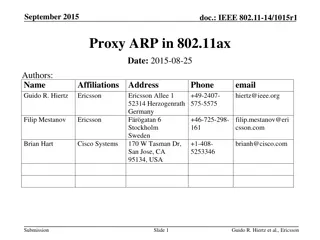IPv6 Enhanced: Key Value for Digital Transformation
Explore how IPv6 plays a crucial role in driving digital transformation, with a focus on policies, societal impact, business opportunities, and stakeholders involved in creating a policy-driven ecosystem for a more inclusive and secure digital society.
0 views • 20 slides
Understanding Computer Network Addressing
Every computer connected to a network has a unique logical address for communication, typically identified using TCP/IP protocol. IP addressing includes Public and Private IPs, Static and Dynamic IPs, and is categorized into IPv4 and IPv6 versions. This study material elaborates on the terminologies
2 views • 28 slides
IPv6 Market to Huge Growth by 2024-2034 _ BIS Research
The IPv6 Market is driven by several key factors shaping its trajectory in the digital landscape. Considering the optimistic scenario, the market is valued at $7.11 billion in 2024 and is expected to grow at a CAGR of 18.96% to reach $40.39 billion by 2034.
5 views • 3 slides
Understanding IPv6 Addressing and Migration Techniques
IPv6 is designed as the successor to IPv4 due to the depletion of IPv4 address space. This lecture covers topics such as the need for IPv6, IPv4 and IPv6 coexistence techniques like dual-stack, tunneling, and translation, IPv6 addressing using the hexadecimal number system, and IPv6 address represen
0 views • 30 slides
Evolution of Internet Protocol: From IPv4 to IPv6
The evolution of Internet Protocol (IP) from IPv4 to IPv6 has been crucial for adapting to new technologies and addressing specific networking challenges. IPv6 offers a 128-bit address space, improved header format, extensibility, and support for a wide range of services including video, voice, and
0 views • 23 slides
Leveraging IPv6-Mostly: A Low-Risk Option for Network Evolution
IPv6-mostly utilizes DHCP Option 108 to enable devices to operate in an IPv6-only mode, enhancing user experience while reducing risk. By leveraging modern technologies like 464XLAT and CLAT, the transition to IPv6 is seamless, with devices automatically adapting to the available network setup witho
0 views • 13 slides
DNS Research Federation: Advancing Understanding of Cybersecurity Impact
The DNS Research Federation, a UK non-profit organization, aims to advance the understanding of the Domain Name System's impact on cybersecurity, policy, and technical standards through education, research, and improved data access. Motivated by the need to measure resolver capabilities, they have d
0 views • 17 slides
Exploring Internet of Things and Emerging Technologies
The concept of Internet of Things (IoT) is transforming everyday objects by enabling them with software, sensors, and network connectivity. This allows for remote control, communication between devices, and data sharing. With the IoT expected to consist of nearly 50 billion objects by 2020, advancem
0 views • 11 slides
Internet Number Resource Report June 2013
This report provides detailed information on the status of Internet number resources as of June 2013, including IPv4 address space allocations, available IPv4 /8s in each Regional Internet Registry (RIR), IPv4 address space issued by RIRs to customers, ASN assignments, 4-byte ASN assignments, and IP
0 views • 18 slides
Insights on IPv6 Reliability Measurements by Geoff Huston at APNIC
Geoff Huston from APNIC conducted IPv6 reliability measurements in May 2019. The study involved comparing IPv4 and IPv6 connections, analyzing TCP connection failures, and highlighting success rates in specific networks like 464XLAT and Reliance JIO in India.
0 views • 29 slides
Fundamentals of Computer Networks
Explore the essentials of computer networks, covering topics such as DHCP, NAT, IPv6, server operations, and IP address allocation. Understand how DHCP servers control IP address pools and provide network configurations to clients. Learn about address leases for dynamic allocation and how DHCP clien
0 views • 35 slides
IPv6 Networking Considerations in xDSL Networks
Practical insights and challenges in implementing IPv6 networking in xDSL networks, discussing rotating prefixes, privacy implications, management of multiple prefixes, prefix size considerations, and strategies for DHCP and L2TP termination. The content also covers security measures, prefix rotatio
0 views • 11 slides
Understanding IP Addressing and Routing in Networking
Delve into the fundamentals of IP addressing, CIDR, subnetting, and network layer protocols like TCP and UDP. Explore the intricacies of Internet architecture, NAT, IPv6, and forwarding techniques. Grasp the essentials of IP datagram format, path-selection algorithms, SDN, and more for a comprehensi
0 views • 22 slides
IPv6 Security and Threats Workshop Summary
David Kelsey from STFC-RAL presented on IPv6 security and threats at the IPv6 workshop pre-GDB at CERN in June 2016. The workshop covered topics such as IPv6 protocol attacks, issues for site network security teams and sys admins, new features of IPv6, security pros and cons, immediate IPv6 concerns
0 views • 29 slides
Understanding IPv6 End Client Measurement Challenges
Adding IPv6 to your website can present risks, potentially impacting client accessibility. Learn about potential issues, measuring end-user behavior without website changes, and using APNIC's web measurement system for insights.
0 views • 27 slides
AERO: Mobile Routing & Addressing System for IP Internetworks
AERO, Asymmetric Extended Route Optimization, is a mobile routing and addressing system designed for IP internetworks like aviation, enterprise, and campus networks. It enables stable IPv6 prefixes for mobile devices, treating them as routers to connect to the Internet of Things. AERO offers feature
0 views • 26 slides
Understanding IP Addressing in Computer Networks
IP addressing provides a seamless network for users by abstracting and providing a uniform addressing scheme used by higher-layer protocols and applications. IP addresses identify connections rather than specific computers, with IPv4 using 32-bit integers and IPv6 using 128-bit addresses. The divisi
0 views • 19 slides
APNIC Internet Resource Analyst Update
Anna Mulingbayan, Senior Internet Resource Analyst and Liaison Officer at APNIC, provides updates on IP address and ASN delegation in the Asia-Pacific region. The content covers IPv4 exhaustion, delegation policies, last /8 delegations, and key policies implemented in 2011. Additionally, it discusse
0 views • 18 slides
Evolution of BGP: Expectations vs. Reality in Protocol Development
BGP has evolved over 30 years from its origins as an advancement of EGP in the 1980s to address issues like routing explosion, IPv6 integration, and imperfections such as session insecurity and protocol instability. Despite challenges, BGP remains a critical component of inter-domain routing, adapti
0 views • 10 slides
Insights into Technology Adoption and Evolution
Delve into the concept of technology adoption driven by factors like utility, consumer demand, marketing, cost, and more. Explore examples of technology-driven transformations and the influence of early adoption on competitive positioning. Uncover the complexities behind the success of IPv4, the cha
0 views • 26 slides
Navigating IPv6 and MPLS Challenges for IPv4 Core Edge Transition
Explore the transition solutions and challenges for integrating IPv6 at the edge of an IPv4 core network, including 6PE, 6VPE, MPLS transport options, and the potential for IPv4 elimination. Discover the evolution toward IPv6 adoption in networking standards and the persistent role of MPLS in modern
0 views • 25 slides
Overview of vRouter Implementation in Openstack Neutron
Virtual router (vRouter) is a crucial component in network virtualization, with applications in cloud environments like Openstack Neutron. This article delves into the concept of vRouter, its importance in IPv6 implementations, and the utilization of VM-based vRouters. It also explores the current s
0 views • 12 slides
Understanding IPv6 ISP Performance: A Detailed Analysis by Geoff Huston
This comprehensive study explores the reliability and speed of IPv6 connections, highlighting factors affecting connection failures. It compares datasets from 2011 and 2015/2016, revealing insights on Teredo, 6to4, and unicast address failures. The findings underscore the importance of addressing is
0 views • 37 slides
Understanding Addressing in Computer Networks
Addressing in computer networks plays a crucial role in efficient communication. Classful addressing, which led to address depletion, has made way for classless addressing and CIDR strategy. In classless addressing, the address space is divided into variable length blocks, allowing for more flexibil
0 views • 17 slides
IPv6 Addressing and Coexistence: Overview and Challenges
This lecture covers essential topics on IPv6 addressing, including IPv4 issues, the need for IPv6, address representation, types, testing, and verification. It explains how IPv6 is designed to overcome the limitations of IPv4, particularly the depletion of the IPv4 address space. The discussion also
0 views • 44 slides
Evolution of IPv6 Adoption in the Networking Industry
IPv6 adoption has reached 30% globally by the start of 2022. However, progress varies among different sectors, with enterprises lagging behind consumer markets. The slow transition is attributed to market saturation, legacy network issues, and cost considerations. Despite the benefits of IPv6 deploy
0 views • 6 slides
The State of IPv6 Transition: Are We Ready to Turn Off IPv4?
Despite decades of effort, the transition from IPv4 to IPv6 has been slow. Currently stuck in Phase 2, with only a small percentage of Internet users having IPv6 capabilities. New deployments lean towards IPv6 but the majority still rely on IPv4, with gradual migrations to dual-stack for legacy netw
1 views • 49 slides
Investigating Anomalous DNS Queries: A Case Study from DNS-OARC 25, Dallas
The exploration uncovers a surge in AAAA queries, leading to a 20% spike in billing. Through meticulous analysis, patterns emerged showing excessive AAAA queries for specific nameservers lacking AAAA glue. Remedies included reaching out to providers and deploying temporary fixes. The resolution invo
0 views • 13 slides
Understanding IP Addresses and Their Classification
IP Addresses, short for Internet Protocol addresses, are unique identifiers assigned to devices on a network. They can be IPv4 or IPv6, with IPv4 having 32 bits and IPv6 being 128 bits. IP addresses are classified into classes A, B, and C, each with specific range and usage. Understanding IP address
0 views • 14 slides
Understanding Network Protocols: TCP, UDP, DHCP, DNS
Explore the fundamentals of key network protocols including TCP, UDP, DHCP, and DNS. Learn about IPv4 and IPv6 addresses, IP address classes, and the roles of these protocols in the TCP/IP suite. Understand the differences between TCP and UDP in terms of connection setup and reliability. Discover th
0 views • 13 slides
Understanding IP Networking Fundamentals
Dive into the world of network layer protocols with a focus on IP, NAT, ICMP, and IPv6. Explore concepts like fragmentation, reassembly, datagram formats, addressing, and subnets, essential for grasping how data is transmitted across networks efficiently and securely.
0 views • 28 slides
IPv6 Public Policy Considerations - Addressing the Global IP Address Shortage
In light of the global shortage of IPv4 addresses, there is a pressing need for a fair policy for the allocation of remaining addresses. The rapid growth of the Internet has further increased demand for IP addresses, with IPv4 expected to run out soon. The deployment of IPv6 has become a critical is
0 views • 23 slides
Comprehensive Review of IP Address Management Software at Shiraz University
IP Address Management (IPAM) is crucial for registering, tracking, and managing IPs efficiently. This open-source software integrates DNS and DHCP, aiding in growth strategies and transitioning to IPv6. By centralizing information, IPAM addresses challenges like IPv4 exhaustion, conflicting IPs, and
0 views • 26 slides
Understanding NAT and IPv6 in Computer Networking
This lecture covers Network Address Translation (NAT) and IPv6 basics in computer networking. It explains how NAT helps in connecting multiple devices to the internet with limited IPv4 addresses, the concept of public and private IP addresses, and the transition to IPv6 for addressing constraints. V
1 views • 31 slides
Understanding IP Datagrams and Header Fields in Computer Networks
This detailed content covers the essentials of IP datagrams and header fields in computer networks. It explains the structure of IP datagrams, key fields in the IP header, and the concept of fragmentation to handle varying Maximum Transmission Units (MTUs) in networks. The illustrations and explanat
0 views • 62 slides
IPWAVE Working Group of IETF: Updated Status Report March 2021
The IPWAVE Working Group at IETF focuses on IP wireless access in vehicular environments, working on V2V and V2I use cases. They are currently emphasizing IPv6 over 802.11-OCB networks, with advancements towards higher bandwidth OCB implementations. The group's main work item involves running an IP
0 views • 10 slides
IPWAVE Working Group of IETF - Status Report March 2020
IPWAVE Working Group of IETF focuses on IP Wireless Access in Vehicular Environments, addressing V2V and V2I use cases. Key items include IPv6 over 802.11-OCB and Problem Statement and Use Cases perspectives. The group collaborates with ISO, SAE, ETSI, and IEEE. Major achievements include RFC 8691 p
0 views • 9 slides
IEEE 802.11-19/2017r0 Service Discovery Advertisement
The document discusses the service discovery requirements for the IEEE 802.11bc amendment, proposing mechanisms such as beacon/periodic frame transmission, eBCS service frame request/response, and ANQP. It emphasizes the need for a broadcast discovery mechanism to cater to listening-only STAs and ou
0 views • 9 slides
Understanding Proxy ARP Implementation in IEEE 802.11ax
Proposed in September 2015, the document discusses the implementation of Proxy ARP with 802.11ax Access Points. It explains the Address Resolution Protocol (ARP), detailing how devices in a LAN communicate using MAC and IP addresses. The submission aims to provide comprehensive explanations on Proxy
0 views • 18 slides
Update on IEEE P802.15 Working Group for Wireless Personal Area Networks (WPANs)
The document provides an overview of the recent activities and upcoming events related to the IEEE P802.15 Working Group for Wireless Personal Area Networks (WPANs), including reports on past IETF meetings and details about the agenda for the upcoming IETF 120 in Vancouver. It describes the working
0 views • 17 slides
